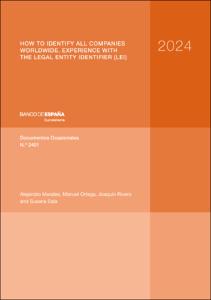Registro completo de metadatos
| Campo DC | Valor |
|---|---|
| dc.contributor.author | Morales Fernández, Alejandro |
| dc.contributor.author | Ortega Ortega, Manuel |
| dc.contributor.author | Rivero, Joaquín |
| dc.contributor.author | Sala, Susana |
| dc.date.accessioned | 2024-03-25T11:11:57Z |
| dc.date.available | 2024-03-25T11:11:57Z |
| dc.date.issued | 2024-01-11 |
| dc.identifier.issn | 1696-2230 (en línea) |
| dc.identifier.issn | 1696-2222 (en papel) |
| dc.identifier.uri | https://repositorio.bde.es/handle/123456789/36259 |
| dc.description.abstract | Como respuesta a la crisis financiera iniciada en 2008, el Consejo de Estabilidad Financiera (FSB) puso en marcha un sistema mundial de registro de personas jurídicas. La iniciativa aspiraba a crear un código de identificación único para cada una de las entidades que operan en los mercados financieros, denominado en inglés código LEI (Legal Entity Identifier), y a mantener tales códigos actualizados. Este documento repasa la historia del proceso de constitución del sistema que gestiona este nuevo código, así como su gobernanza y regulación. Se analizan los beneficios, límites y retos que representa crear un sistema mundial de identificación de agentes que debe estar operativo en mercados y jurisdicciones con diferentes normativas mercantiles y usos en la gestión de este tipo de información. En este sentido, debe destacarse que la existencia de registros administrativos públicos donde se identifiquen las sociedades no constituye un estándar en muchos países, lo que afecta a la calidad y cobertura que puede alcanzarse con un código único mundial como el LEI. |
| dc.description.abstract | In response to the financial crisis that began in 2008, the Financial Stability Board (FSB) launched a global registration system for legal entities. The initiative aimed to create a unique identifier – the LEI (Legal Entity Identifier) – for each of the entities operating in the financial markets and to keep these codes updated. This document reviews the history of the process of establishing the system that manages this new code, as well as its governance and regulation. The benefits, limits and challenges of creating a global entity identification system that must be operational in markets and jurisdictions with different commercial regulations and uses in the management of this type of information are analysed. In this sense, it should be noted that having in place public administrative registries for identifying corporations is not standard practice in many countries and this affects the quality and coverage that can be achieved with a single global code such as the LEI. |
| dc.format.extent | 35 p. |
| dc.language.iso | en |
| dc.publisher | Banco de España |
| dc.relation.ispartof | Documentos Ocasionales / Banco de España, 2401 |
| dc.relation.hasversion | Versión en español 123456789/35888 |
| dc.rights | Reconocimiento-NoComercial-CompartirIgual 4.0 Internacional (CC BY-NC-SA 4.0) |
| dc.rights | In Copyright - Non Commercial Use Permitted |
| dc.rights.uri | https://creativecommons.org/licenses/by-nc-sa/4.0/deed.es_ES |
| dc.rights.uri | http://rightsstatements.org/vocab/InC-NC/1.0/ |
| dc.subject | LEI |
| dc.subject | Identificador global |
| dc.subject | Identificador mundial |
| dc.subject | Código de identificación |
| dc.subject | GLEIF |
| dc.subject | ROC |
| dc.subject | LOU |
| dc.subject | Recomendación FSB |
| dc.subject | EMIR |
| dc.subject | LEI challenge |
| dc.subject | Global identifier |
| dc.subject | World identifier |
| dc.subject | Identification code |
| dc.subject | FSB recommendation |
| dc.subject | Mercados financieros |
| dc.subject | Datos microeconómicos |
| dc.title | How to identify all companies worldwide. Experience with the Legal Entity Identifier (LEI) |
| dc.type | Documento de trabajo |
| dc.identifier.bdebib | 000475393 |
| dc.identifier.bdepub | DOCA-202401-eng |
| dc.subject.bde | Regulación y supervisión de instituciones financieras |
| dc.publisher.bde | Madrid : Banco de España, 2024 |
| dc.subject.jel | C81 |
| dc.subject.jel | D04 |
| dc.subject.jel | F42 |
| dc.subject.jel | G28 |
| dc.identifier.doi | https://doi.org/10.53479/36259 |












